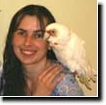Breeding Gouldians
Kristen Reeves, Meadowlark Farms Avian Supply, Inc.
Before you start breeding your birds, you'll need time to prepare them. It is imperative, for your birds’ health and breeding success, that you do not breed them if they are not properly prepared. Gouldians have several distinct cycles they must pass through to be successful breeders and remain happy, healthy and prolific.
For more information about their cycles, see Laraine's article "Cycle of the Seasons"
MATURITY IS THE FIRST THING TO CONSIDER
Before you get too carried away, you want to make sure you have a very healthy pair of birds that get along well with one another. For the best chance of success, they should be AT LEAST a year old, but preferably two years old. Breeding issues all seem to revolve around maturity or lack thereof in the breeding pair. If the hen is too young, she could experience egg binding - a potentially deadly health problem - or she might toss eggs and/or chicks. A young cock bird, in his eagerness to impress the hen, may try to continue building the nest right over the top of the eggs! Copulation between young birds may not be successful in their eagerness. Young birds may feel there is an invader in the nest once the chicks hatch and thus toss them. If you wait until they are mature, you should avoid many of these issues!
LIGHT, HEAT & HUMIDITY
“In nature, the reproductive season is triggered by a change in the photoperiod (as hours of daylight lengthen) coupled with the availability of food. Gouldian finches inhabit an area where they usually breed when adequate grass and seeds of other plants, as well as insects are available...” Matthew M. Vriends, PhD, 1937
Light - Lady Gouldians need 13+ hours of sunlight to trigger their breeding instincts. If you use timers on your lights, you can gradually adjust the lighting over time to have them ready to breed when YOU want them to breed! I begin to adjust my birds for the breeding season about mid-October when I start to add an hour to their light every three days or so. By mid-November to early December, the birds are getting their full 13 hours of light, hence triggering their breeding instinct. My timers are set so that each timer goes on within 15 minutes of each other. During breeding season, the first bank of lights comes on at 4:15 a.m., the rest come on at 4:30 and 4:45 a.m. They begin to go off at 6:00 p.m., again at 15 minute intervals. These settings allow the birds to wake up slowly, and at night, find a place to roost without going to total darkness all at once.
Near the end of June to mid July, I being to change the timers so that one goes off 1/2 hour sooner, while the rest stay the same until I've brought them down to a consistent 12 hour day. The fewer hours of light also tell the birds it is time to molt though they often begin their annual molt within a week or so of me removing the nest boxes. They will then begin the cycle all over again as the rich breeding foods are removed until October 1st and when the lights are timed to prepare them again!
Heat - I have always allowed my bird room to acclimate to the outside temperature of my area - I leave a window open at all times unless the temperature is below 50 degrees. In the cooler months I use an electric space heater to keep the room at least 68 degrees. My birds do not seem to mind the cooler temperatures and breed well, even though many breeders will tell you to keep your birds between 70 and 75 degrees. I have never kept them at the very high temperatures discussed by other breeders. I feel the normal household temperatures are better for the birds and for new owners once they purchase them.
It is my humble opinion that the worry over heat required by chicks to empty their crops effectively is unwarranted. The heat produced by the parents while sitting on them keeps them adequately warm!
Again, this is just my opinion and experience.
Humidity - Here is where we get a little sticky (no pun intended). Gouldians do need humidity, but not necessarily the “tropical” humidity they would receive in the wild. Humidity is important to ensure a successful breeding season. The birds also need humidity to keep in good skin and feather. It is also highly important for the eggs. Chicks attempting to hatch in an overly dry environment may have difficulty as the egg membranes dry out faster while they attempt to leave the shell. For best success, the breeding room should not have less than 35-45% humidity and no more than 50%. You might want to keep a humidifier on hand if you decide to breed your birds mid-winter when your furnace is running, or if you have no way to keep central air conditioning from drying out your bird room.
Again, this is merely my experience. Other breeders may have a different opinion.
NUTRITION FOR SUCCESS
To bring your birds into breeding condition, you'll need to adjust their feed several months in advance. For instance, if you begin your breeding season in December as I do, you'll want to begin the breeding season by running them through Austerity. I typically start my Austerity diet on September 1st. It runs for a full month (4 weeks). Austerity forces any birds that may still be in condition to drop out of condition. It shrinks the reproductive organs, and allows the birds to drop the weight they may have gained while eating their breed/molt or resting diets. Once all the birds have completed Austerity, they are then blanks slates and ready to be brought up to breeding speed! If you keep the sexes separate when not breeding, you will also be able to pair the birds any way you wish once they come back into condition.
If you’ve completed a month of Austerity, come October first the birds will be primed to begin their breeding diet – which will be offered for a full month before the birds are paired. A diet to prepare for breeding should be high in protein, fatty acids, vitamins, minerals and trace elements.
You want to be certain you are feeding them a seed mix designed for AUSTRALIAN finches – or Gouldians, specifically. Protein can be found in many of their seeds, but not in the amounts they require to prepare their bodies for the rigors of the breeding season. For additional protein they may be offered chitted seed, boiled egg, or a commercial egg food. If you are up to feeding insects, Gouldians will readily eat small meal worms and fly larvae. If you choose to feed live insects, you should be sure to run your birds through a deworming protocol at least quarterly! You want to get your birds used to any items you wish them to feed to their young. Gouldians are notoriously picky eaters – get ‘em young, train ‘em right!
They should be given a multivitamin supplement (administered in the water or mixed into their soft food), and ample amounts of calcium and iodine CONSISTENTLY and ON A SCHEDULE. Read the directions on the labels of the supplement system you have chosen and follow it to the letter. Do not deviate, and do not skip days. If it says two days per week, make sure you consistently offer the supplement on the same days NEXT week as you did THIS week.
They should be offered a grit mix containing both soluble and insoluble forms of calcium and trace minerals. You may choose to offer oyster shell, grit, shaved cuttlebone and trace elements in a treat cup or add liquid iodine and calcium in their water or on their soft food.
If you do not use and follow the Dr. Rob Marshall Supplementation System, using a breeding aid supplement will help tremendously.
CHOOSING A BREEDING SEASON
If you follow the steps above in the Light, Heat & Humidity section and have a little patience, you can pretty much choose your own breeding season though the birds tend to breed more easily when bred on their natural wild schedule.
You'll want to know the birth dates of your birds, and you'll want to know when they last had a full molt.
You can slowly begin adjusting them to breed on YOUR schedule but it takes time, especially if it is different from the aviary in which they were born. Australia is nearly opposite in terms of seasons in the US, so it is important that if you attempt to breed your birds on YOUR schedule, you take ample time to prepare them. It took my very first pair well over two years to adjust to my schedule. Once I began breeding them I took additional time to prepare their young. Because of this, I had several breeding pairs raising clutches at different times of the year. BUT, once I began to use timers, the birds reverted back to their internal clocks and their clocks seem to know what's best! Now I have all but a few pairs breeding on their own time – Australian time. On Australian time, they breed more prolifically, tend to be better parents, and fall prey to fewer breeding stress related issues.
Have patience and prepare them carefully and you should have no problems getting them to breed and raise one successful clutch after another (but please limit them to no more than 3 clutches per hen per season!)
A FINAL WORD
It is so very important that your birds are -
- Mature
- In good breeding condition
- Fed the appropriate nutrients to get their bodies ready for the rigors of the breeding season.
- If you are not certain of the age of your birds, or if you are not sure what they have been fed previous to your owning them, give them a season off. In other words, wait a season to breed them and prepare them carefully!
Take the time to do it right so that your birds remain healthy and you have a successful breeding season!





